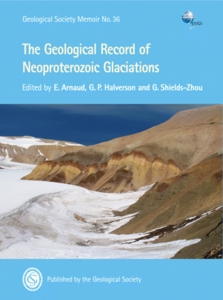The record of Neoproterozoic glaciation in the Taoudéni Basin, NW Africa
Shields-Zhou, G.A., Deynoux, Max, and Och, Lawrence (2011) The record of Neoproterozoic glaciation in the Taoudéni Basin, NW Africa. In: Arnaud , Emmanuelle, Halverson, Galen P., and Shields-Zhou, Graham, (eds.) The Geological Record of Neoproterozoic Glaciations. Geological Society, London, Memoirs, 36 . Geological Society of London, Bath, UK, pp. 163-171.
![[img]](https://researchonline.jcu.edu.au/21031/5.hassmallThumbnailVersion/memoirs_cover.gif)
|
Image (GIF) (Book Cover)
- Cover Image
Download (75kB) |
|
|
PDF (Published Version)
- Published Version
Restricted to Repository staff only |
Abstract
The Taoudéni Basin covers over 1 000 000 km2 of the West African Craton, bounded by Pan-African orogenic belts. Four supergroups separated by craton-scale unconformities are recognized, with Neoproterozoic glaciogenic deposits occurring at the base of Supergroup 2. The Jbéliat Group occurs along a continuous, 1300-km-long, narrow belt from the Adrar region of Mauritania to the eastern limit of the Hank in Algeria and comprises thin glacial drift capped widely by periglacial polygonal structures, with more complex glacial sequences preserved in palaeo-depressions. A thicker, variously marine and continental glaciogenic succession can be found in southern parts, while fully marine, glacially influenced successions are only known from the extreme SW of the basin. The 'triad' sequence of diamictites overlain by barite-bearing 'cap' dolostones and then by green shales and/or bedded cherts (silexites) is ubiquitous and has long been used to correlate the Supergroup 1/2 boundary across the basin and into the surrounding orogenic belts. The bedded cherts commonly show a volcanic influence and are cemented by early marine calcite at their base at Adrar, Mauritania. Although fossil-based age constraints are scarce and ambiguous, regional tectonic events indicate that 'triad' deposition occurred between the Bassaride (665–655 Ma) and Dahomeyide (610–580 Ma) orogens. Recent U–Pb zircon studies of ignimbrite tuffs provide a minimum age for the glaciation of c. 600 Ma. Correlation of supergroup 2 glacial deposits with the c. 635 Ma end-Cryogenian ('Marinoan') glaciation is likely and is supported by limited carbon and strontium isotope data. Barite is commonly found within the cap carbonate and may relate to methane seepage and/or unusual oceanographic conditions after deglaciation. Several studies have attributed sequence complexity within the post-glacial succession to isostatic reequilibration. The Taoudéni Basin represents a rare Neoproterozoic example of terrestrial tillites and associated periglacial facies.
| Item ID: | 21031 |
|---|---|
| Item Type: | Book Chapter (Research - B1) |
| ISBN: | 978-1-86239-334-9 |
| ISSN: | 2041-4722 |
| Related URLs: | |
| Date Deposited: | 23 Apr 2012 05:38 |
| FoR Codes: | 04 EARTH SCIENCES > 0403 Geology > 040311 Stratigraphy (incl Biostratigraphy and Sequence Stratigraphy) @ 60% 04 EARTH SCIENCES > 0402 Geochemistry > 040203 Isotope Geochemistry @ 40% |
| SEO Codes: | 97 EXPANDING KNOWLEDGE > 970104 Expanding Knowledge in the Earth Sciences @ 100% |
| Downloads: |
Total: 146 Last 12 Months: 5 |
| More Statistics |



